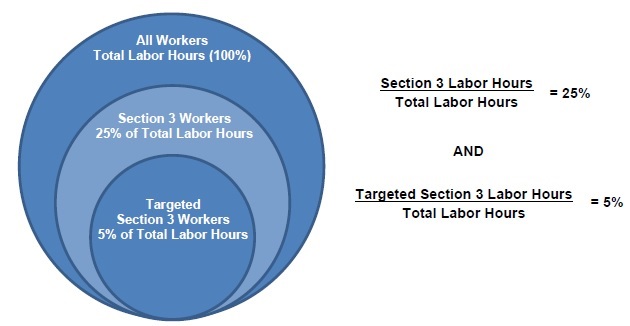Section 3 Compliance
Compliance Benchmarks
HUD has set the following benchmarks as an indicator of compliance with Section 3:
- Twenty-five (25) percent or more of the total number of labor hours worked by all workers on a Section 3 Project are performed by Section 3 workers; and
- Five (5) percent or more of the total number of labor hours worked by all workers on a Section 3 Project are performed by Targeted Section 3 workers.

Qualitative Efforts
Subrecipients and contractors must engage in qualitative efforts to satisfy the Section 3 benchmarks and provide economic opportunities to Section 3 workers and business concerns. Examples of such efforts may include, but are not limited to the following:
- Applicant Outreach –
- Engage in outreach efforts to generate job applicants who are Targeted Section 3 workers, including posting job openings at the job site, HUD Opportunity Portal, social media pages, and other platforms.
- Clearly indicate Section 3 eligibility on all job postings, notifications, and advertisements with the following statement: “This is a Section 3 eligible job opportunity. We encourage applications from individuals that are low-income, live in public housing, and/or receive a Section 8 voucher.”
- Include the Section 3 Worker Self-Certification form in all job postings.
- One-Stop / YouthBuild Outreach – Engage in outreach or referrals with local YouthBuild programs, Louisiana Workforce Commission, JOB 1, or other community organizations to assist with training and recruiting Section 3 and Targeted Section 3 workers.
- Training and Apprenticeship – Provide training or apprenticeship opportunities.
- Job Fairs – Hold one or more job fairs, or sponsor a job informational meeting in the Service Area / Neighborhood of the Project.
- Business Concern Outreach –
- Engage in outreach efforts to identify and secure bids from Section 3 businesses by advertising notices of contracting opportunities and related information on the HUD Opportunity Portal and local community papers.
- Provide written notice to all known Section 3 business concerns, with sufficient time for interested businesses to respond to bid invitations.
- Send notice of contracting opportunities to local community development organizations, business development organizations, or minority contracting associations.
- State clearly in all notices that the contracting opportunity is Section 3 eligible, and include a copy of the Section 3 Business Concern Certification form.
- Competition Assistance – Provide technical assistance to help Section 3 business concerns understand and bid on contracts.
- Contract Sizing – Size, split, or divide contracts into smaller jobs to facilitate participation by Section 3 business concerns, particularly where economies of scale or efficiency of delivery are not factors. [2 CFR 200.321(b)(3)]
- Bidder Viability Support – Provide bonding assistance, guaranties, or other efforts to support viable bids from Section 3 business concerns.
- Business Registries – Promote use of the HUD Opportunity Portal or other business registries designed to create opportunities for disadvantaged and small businesses.
In addition to efforts to meet the benchmark goals directly, subrecipients and contractors can also engage in other activities aimed at aimed at increasing economic opportunities for Section 3 workers and businesses. Examples of such efforts may include, but are not limited to the following:
- Employment Assistance – Provide technical assistance to help Section 3 workers compete for jobs, or connect them with assistance in seeking employment, including:
- Resume assistance
- Interview preparation
- Coaching
- Job placement services
- Work Readiness and Retention – Provide or refer Section 3 workers to services supporting work readiness and retention, such as:
- Interview clothing
- Licensing or testing fees
- Transportation
- Childcare
- Financial Literacy – Help Section 3 workers obtain financial literacy training or coaching.
- Education Assistance – Provide assistance to Section 3 workers to apply for or attend:
- Community college
- Four-year educational institution
- Vocational or technical training
Contractors searching for certified Section 3 businesses and workers may email Section3@nola.gov, or search the HUD Section 3 Opportunity Portal.
Contracting Procedures: Bid / RFP/RFQ / NOFA
Section 3 compliance is part of the City's procurement and contracting process for projects or activities funded by HUD housing and community development assistance.
In a competitive bid, the two lowest bidders must submit a Section 3 Plan as part of their post-bid documents submission. Contractors submitting proposals or qualifications must include a Section 3 Plan as part of their submission. Agencies and developers applying for Section 3 covered funding must submit a Section 3 Plan with their application.
After selection, the successful bidder, respondent, or applicant must collect a Section 3 Plan from each of its identified contractors or subcontractors and submit to the Office of Community Development. Please note that all Section 3 Plans must be received by the City before the contract can be executed.
Throughout the covered project, subrecipients, contractors, and subcontractors are monitored for compliance. Upon request, they are required to submit the Section 3 Compliance Report and documentation showing their qualitative efforts to comply with Section 3.